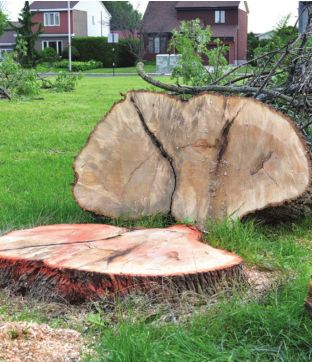So let’s form a commission
Tree care at my house is easy.
In the front yard is a dogwood, which largely takes care of itself. Not too big, not too small, grows slow and perhaps fools passersby into thinking some thought was put into its planting. In the backyard, a big tree once existed, species uncertain, which I discovered whilst replanting lawn. Confronted with a massive stump inches below ground level, I took a cue from Native American canoe makers and bought charcoal, the kind used to barbecue steaks and hamburgers. After heaping briquets atop the stump, I lit a match and, after a day or two, it was burned down to a suitable point, plus I roasted a few weenies. That’s my kind of yardwork.
The city of Springfield has a more difficult challenge. We have a tree gap, huggers of oaks and other species say, and the difference between trees we have and the number we should have, depending on who’s talking, sounds apocalyptic, or at least alarming. Consult the internet and you’ll learn that trees can solve global warming, decrease crime, increase retail spending, boost infant birth weight, reduce opioid use and otherwise cure anything.
Anne Logue, a Sustainable Springfield board member, has done the math with the help of GIS technology and a University of Illinois Springfield student and determined that 24 percent of our city is shaded by trees. That’s not ideal. Heck, we trail Chicago, where Cook County’s tree canopy stands at 29 percent,1% shy of what folks figure should be the goal.
Jeffrey Reim, city arborist, agrees that we’re behind. The emerald ash borer has taken its toll – already, the city has cut down hundreds of ash trees, Reim says, and plans on falling 2,000 more, and that doesn’t include doomed ash trees on private property.
Forget trees falling in forests. I hadn’t noticed, until someone told me, that honey locusts lining Monroe Street disappeared years ago. Same thing with trees alongside Monument Avenue leading into Oak Ridge Cemetery. The city figured the trees, being magnets for itty-bitty worms, were nuisances. “They would be all over people, all over cars,” Reim recalls. Overspray from anti-worm concoctions would scar nearby brick, and so the city broke out chainsaws, then discovered that roots had a death grip on underground gas lines and couldn’t be removed. It’s not clear whether anyone thought of charcoal briquets, but, in any case, Reim says there is no practical way to replant over stumps and no practical way to remove stumps, and so the city is considering planter boxes.
The city’s list of undesirable trees deemed wrong for public property has swelled in recent years to include more than 30 species. In addition to honey locusts, apple, common pear and wild cherry trees are verboten. Crabapple trees are acceptable, but who likes crabapples?
Without apples, Adam and Eve may never have gained knowledge. Absent an apple, Isaac Newton might not have noticed gravity. The Beatles well knew that apples are good, as did Steven Jobs. And, always, there is cider, as American as apple pie. What gives? Too much fruit, apparently. We can’t be trusted to put apples, or pears, to good use, and the city doesn’t want them rotting or clogging storm drains.
In 1997, when the list of undesirable species stood at 27, a tree war exploded as the city council approved an ordinance allowing anyone to chop from public property any tree on the list without a permit. That prompted horticulturist David Robson to resign from the city’s tree commission, which hadn’t been consulted before aldermen -- and yes, alders are on the undesirable list -- turned the populace into potential Paul Bunyans. This, Robson then declared, was the worst thing to happen to Springfield since Lincoln’s assassination, notwithstanding the 1908 race riot. The ordinance soon was repealed. The city’s tree commission, also, has died.
The commission today exists on paper only. There are calls for resurrection. Mary Frances, who’s written letters and spoken before the city council, says she’s been given the thanks-for-playing-next-contestant-please by city officials. She tells me that slaughtered sycamores prompted her to urge Mayor Jim Langfelder to appoint members to the dormant commission.
Opinions on sycamores vary, but Logue and Robson say that revitalizing the tree commission would be a good thing. Private efforts have fallen short. Todd Renfrow, who heads Springfield Green and was architect of coal-fired Dallman 4 while manager of City Water, Light and Power under former Mayor Tim Davlin, says the private organization, revitalized a year ago, hopes to plant between 200 and 400 trees. He can’t say when. On the plus side, the city plans to spend $30,000 this year on planting trees.
The more trees the merrier, and I’m not sure we’ve been merry enough. Springfield once was a Tree City USA, a designation bestowed by the Arbor Day Foundation, a nonprofit blessed by the U.S. Forest Service, to signify cities that dig trees. We no longer have that moniker. The foundation blesses tree commissions: “Involving residents and business owners creates wide awareness of what trees do for the community and provides broad support for better tree care.”
So appoint folks, Mayor Langfelder, and let’s pick some apples.
Contact Bruce Rushton at [email protected].
Editor’s note
My
goodness we’re in Code Red again and there’s another “cyclone bomb”
headed our way, the second in three weeks. If we didn’t know such scary
terms we’d think it’s just spring in Illinois, bringing unpredictable
weather, warm one day and chilly the next, windy with a chance of rain.
–Fletcher Farrar, editor and CEO